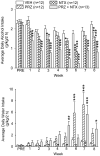Prazosin + Naltrexone Decreases Alcohol Drinking More Effectively Than Does Either Drug Alone in P Rats with a Protracted History of Extensive Voluntary Alcohol Drinking, Dependence, and Multiple Withdrawals
- PMID: 26260061
- PMCID: PMC4558320
- DOI: 10.1111/acer.12828
Prazosin + Naltrexone Decreases Alcohol Drinking More Effectively Than Does Either Drug Alone in P Rats with a Protracted History of Extensive Voluntary Alcohol Drinking, Dependence, and Multiple Withdrawals
Abstract
Background: Prazosin (PRZ; an α1 -adrenergic receptor antagonist) and naltrexone (NTX; a nonspecific opioid receptor antagonist) each decrease alcohol drinking when administered to rats selectively bred for high voluntary alcohol drinking (alcohol-preferring or "P"), and the combination of PRZ + NTX decreases alcohol drinking more effectively than does either drug alone. As drug responsiveness can depend on history of alcohol drinking and dependence, we investigated whether various schedules of PRZ and NTX administration, alone or in combination, are effective in decreasing alcohol drinking in male P rats with a history of protracted voluntary alcohol drinking, dependence, and repeated withdrawals closely resembling human alcoholism.
Methods: Male P rats became alcohol-dependent during 1 year of ad libitum 24 h/d access to food, water, and 20% alcohol with repetitive temporary alcohol withdrawals. Four sequential studies then addressed effects of oral PRZ (2 mg/kg) and NTX (10 mg/kg), alone or together, on alcohol drinking during: (i) daily alcohol access with daily drug treatment, (ii) intermittent alcohol access with daily drug treatment, (iii) intermittent alcohol access with occasional drug treatment, and (iv) postdeprivation reinstatement of alcohol access.
Results: The combination of PRZ + NTX consistently suppressed alcohol drinking during daily or intermittent alcohol access conditions and when drug treatment was either daily or occasional. PRZ + NTX was consistently more effective than either drug alone. The reduction in alcohol drinking was not due to sedation, motor effects, or malaise.
Conclusions: Both daily and "as-needed" treatment with PRZ + NTX are highly effective in suppressing daily, intermittent, and postdeprivation alcohol drinking in male P rats with a protracted history of alcohol dependence and repeated withdrawals. This drug combination may be especially effective for treating individuals with long histories of heavy alcohol abuse, dependence, and repeated relapse, as commonly encountered in clinical practice.
Keywords: Alcohol; Alcoholism Treatment; Naltrexone; Noradrenergic; Opioid; Prazosin.
Copyright © 2015 by the Research Society on Alcoholism.
Figures







Similar articles
-
Combining naltrexone and prazosin in a single oral medication decreases alcohol drinking more effectively than does either drug alone.Alcohol Clin Exp Res. 2013 Oct;37(10):1763-70. doi: 10.1111/acer.12148. Epub 2013 Jul 22. Alcohol Clin Exp Res. 2013. PMID: 23875623 Free PMC article.
-
Combining Varenicline (Chantix) with Naltrexone Decreases Alcohol Drinking More Effectively Than Does Either Drug Alone in a Rodent Model of Alcoholism.Alcohol Clin Exp Res. 2016 Sep;40(9):1961-70. doi: 10.1111/acer.13157. Epub 2016 Jul 29. Alcohol Clin Exp Res. 2016. PMID: 27469281 Free PMC article.
-
Combining the α1 -adrenergic receptor antagonist, prazosin, with the β-adrenergic receptor antagonist, propranolol, reduces alcohol drinking more effectively than either drug alone.Alcohol Clin Exp Res. 2014 Jun;38(6):1532-9. doi: 10.1111/acer.12441. Epub 2014 May 30. Alcohol Clin Exp Res. 2014. PMID: 24891220 Free PMC article.
-
The status of naltrexone in the treatment of alcohol dependence: specific effects on heavy drinking.J Clin Psychopharmacol. 2006 Dec;26(6):610-25. doi: 10.1097/01.jcp.0000245566.52401.20. J Clin Psychopharmacol. 2006. PMID: 17110818 Review.
-
Intramuscular extended-release naltrexone: current evidence.Ann N Y Acad Sci. 2011 Jan;1216:144-66. doi: 10.1111/j.1749-6632.2010.05900.x. Ann N Y Acad Sci. 2011. PMID: 21272018 Review.
Cited by
-
A Genetic Animal Model of Alcoholism for Screening Medications to Treat Addiction.Int Rev Neurobiol. 2016;126:179-261. doi: 10.1016/bs.irn.2016.02.017. Epub 2016 Mar 21. Int Rev Neurobiol. 2016. PMID: 27055615 Free PMC article. Review.
-
Acute Hypophagia and Changes in c-Fos Immunoreactivity in Adolescent Rats Treated with Low Doses of Oxytocin and Naltrexone.J Clin Med. 2021 Dec 23;11(1):59. doi: 10.3390/jcm11010059. J Clin Med. 2021. PMID: 35011797 Free PMC article.
-
Neurogenetics and Epigenetics of Loneliness.Psychol Res Behav Manag. 2023 Nov 29;16:4839-4857. doi: 10.2147/PRBM.S423802. eCollection 2023. Psychol Res Behav Manag. 2023. PMID: 38050640 Free PMC article. Review.
-
Influence of stress associated with chronic alcohol exposure on drinking.Neuropharmacology. 2017 Aug 1;122:115-126. doi: 10.1016/j.neuropharm.2017.04.028. Epub 2017 Apr 19. Neuropharmacology. 2017. PMID: 28431971 Free PMC article. Review.
-
Evaluation of the effect of doxasozin and zonisamide on voluntary ethanol intake in mice that experienced chronic intermittent ethanol exposure and stress.Alcohol. 2020 Dec;89:37-42. doi: 10.1016/j.alcohol.2020.07.005. Epub 2020 Jul 24. Alcohol. 2020. PMID: 32712186 Free PMC article.
References
-
- Amit Z, Brown ZW, Levitan DE, Ogren SO. Noradrenergic mediation of the positive reinforcing properties of ethanol. I. Suppression of ethanol consumption in laboratory rats following dopamine-beta-hydroxylase inhibition. Arch Int Pharmacodyn Ther. 1977;230:65–75. - PubMed
-
- Anton RF, O’Malley SS, Ciraulo DA, Cisler RA, Couper D, Donovan DM, Gastfriend DR, Hosking JD, Johnson BA, LoCastro JS, Longabaugh R, Mason BJ, Mattson ME, Miller WR, Pettinati HM, Randall CL, Swift R, Weiss RD, Williams LD, Zweben A. Combined pharmacotherapies and behavioral interventions for alcohol dependence. The COMBINE study: a randomized controlled trial. JAMA. 2006;295:2003–2017. - PubMed
-
- Bell RL, Rodd ZA, Lumeng L, Murphy JM, McBride WJ. The alcohol-preferring P rat and animal models of excessive alcohol drinking. Addiction Biol. 2006;11:270–288. - PubMed
-
- Colombo G, Maccioni P, Vargiolu D, Loi B, Lobina C, Zaru A, Carai MAM, Gessa GL. The dopamine β-hydroxylase inhibitory, nepicastat, reduces different alcohol-related behaviors in rats. Alcohol Clin Exp Res. 2014;38:2345–2353. - PubMed
-
- Curtis AL, Lechner SM, Pavcovich LA, Valentino RJ. Activation of the locus coeruleus noradrenergic system by intracoerulear microinfusion of corticotropin-releasing factor: effects on discharge rate, cortical norepinephrine levels and cortical electroencephalographic activity. J Pharmacol Exp Ther. 1997;281:163–172. - PubMed
Publication types
MeSH terms
Substances
Grants and funding
LinkOut - more resources
Full Text Sources
Other Literature Sources
Medical
Research Materials

